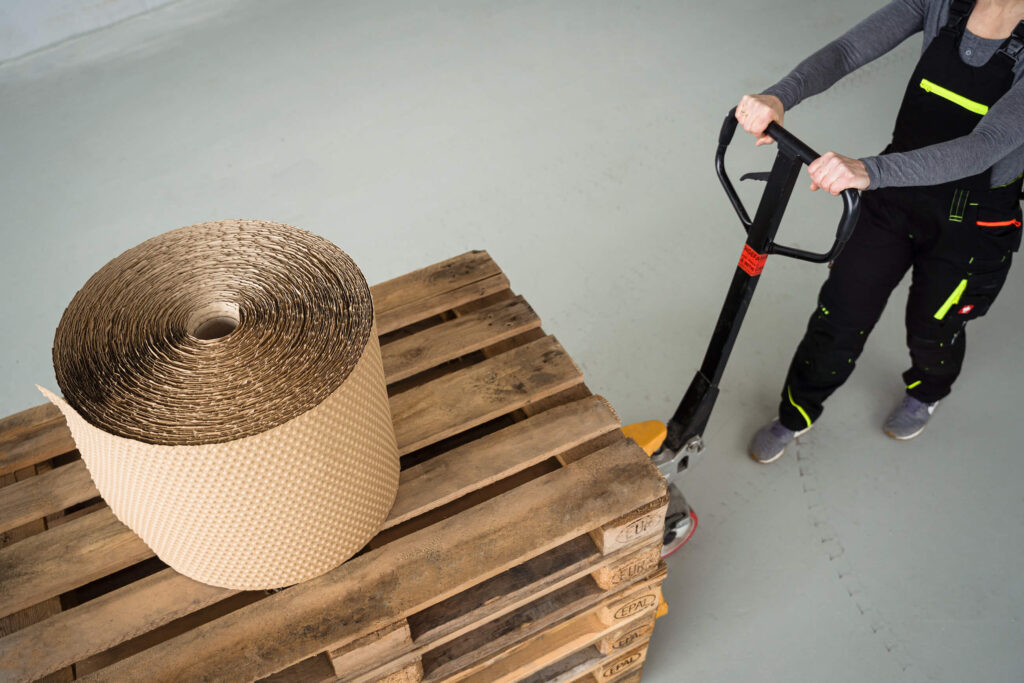The Quest for Sustainable Packaging: Industry Leaders Reshape Environmental Responsibility

As industries grapple with the urgent need for sustainable practices, the arena of packaging has emerged as a pivotal battleground in the quest for environmental responsibility. Companies across the globe are reimagining their packaging strategies, aligning with circular economy principles to reduce waste and carbon footprints.
DS Smith, a key player in the packaging industry, has embraced sustainability as an integral part of its business model. Guided by a robust sustainability strategy, the company’s partnership with the Ellen MacArthur Foundation has been a driving force behind its circular approach. Miles Roberts, Group Chief Executive of DS Smith, acknowledges the rapidly evolving global landscape, including challenges like COVID-19, supply chain disruptions, energy crises, climate change, and biodiversity loss.
In response, DS Smith has identified four key areas—circularity, carbon reduction, people and communities, and nature—where they aim to make a positive impact. Their circularity efforts encompass designing packaging that minimizes waste and pollution while promoting extended material usage. DS Smith’s commitment to innovation and collaboration is evident through its target to remove a billion pieces of problem plastics by 2025, along with pilot projects focusing on reuse solutions.

“By engaging our people, inspiring our communities, encouraging our suppliers, and supporting our customers, we can lead the transition to the low-carbon circular economy.” — Miles Roberts, Group Chief Executive of DS Smith
As a testament to the packaging industry’s changing dynamics, DS Smith’s strategy reflects a dynamic response to current global challenges. The company’s commitment to circularity, sustainable practices, and environmental responsibility underscores the need for a holistic approach to redefining packaging norms for a more sustainable future.
Amidst this transformative packaging landscape, Patagonia, an important name in the apparel industry, has emerged as a beacon of sustainability. Recognizing the industry’s significant contribution to global greenhouse gas emissions, Patagonia has been in persistent pursuit of change. By prioritizing the use of preferred materials, such as organic and recycled fibers, Patagonia aims to mitigate the environmental impact of its products.
As the apparel industry contributes a staggering 6.7% of global greenhouse gas emissions and releases billions of tons of CO₂e annually, the urgency of addressing its environmental impact cannot be overstated. Quantitative data underscores the gravity of the situation, with a dire warning that failing to alter this trajectory could lead to catastrophic consequences of climate change. The disturbing reality of excessive waste, fueled by overconsumption and improper disposal of garments, amplifies the industry’s detrimental effects. Patagonia’s commitment to environmental transformation is palpable. Recognizing its profound environmental footprint, the company has embarked on a journey to minimize its contribution to this crisis.
Patagonia’s multifaceted approach spans across its entire value chain, from materials manufacturing to end-of-life disposal, cementing its dedication to a more sustainable future.
Patagonia’s dedication to sustainability is evident in its resolute efforts to reduce the environmental impact of its operations. The company’s strategy extends beyond superficial changes, focusing on essential elements of its business, such as renewable energy adoption and materials sourcing. Patagonia acknowledges that the challenge lies not only in their owned and operated facilities but also in the intricate web of their supply chain. Their commitment to eliminating virgin petroleum fiber from their products by 2025 and transitioning to preferred materials is a testament to their determination to drive positive change.

“Leipa’s mission – Environmental protection at all levels.”
Their embrace of recycled polyester exemplified by products like the Better Sweater jackets showcases their proactive stance in curbing fossil fuel reliance. This transition has already prevented a significant amount of CO₂ from entering the atmosphere, underscoring Patagonia’s tangible contributions to emissions reduction. Moreover, their ambitious goals for packaging sustainability signify their holistic approach, as they strive to make every aspect of their business more environmentally friendly, including the reduction of paper usage and the pursuit of 100% reusable and compostable packaging by 2025.
Amidst the intricate web of score-related inputs, data, and perspectives that converge during the product development journey, Annika Washburn, Quality Insights and strategy manager at Patagonia, emerges as the guiding force. Washburn assumes the pivotal role of orchestrating this intricate dance of information. With a multifaceted responsibility, she not only navigates the intricacies of the scoring process but also propels it forward with unwavering determination. The confluence of design, research, and testing necessitates astute management, and Washburn’s expertise shines in this role.
In her capacity, Washburn leads the orchestration of scoring shifts and improvements, ensuring that the company’s commitment to quality and sustainability remains at the forefront. Recognizing the need for continual evolution, she was instrumental in the introduction of repairability to the scoring system in 2016. With her collaboration with Yvon Chouinard led to the elevation of factors such as durability, functionality/multifunctionality, and environmental impact—essentially the bedrock of their product philosophy. These aspects, now double-weighted, exemplify Washburn’s dedication to crafting a holistic evaluation framework that aligns with the company’s ethos.
Leipa, a German paper mill, offers a case study in operational transformation for environmental gains. Recognizing the significance of every process step, Leipa collaborated with Andritz to revamp their screening plant. Through the integration of advanced technology, Leipa sought to reduce fiber losses and improve pulp quality, demonstrating the critical role of technological innovation in sustainable production. By optimizing energy consumption and refining screening processes, Leipa underscores the multifaceted nature of environmental protection within manufacturing industries.
Sebastian Stockfisch, head of the deinking plants and the effluent treatment system at Leipa talks about the mill’s dedication to environmental protection and its commitment to every step of the production process, stating, “Leipa’s mission – Environmental protection at all levels.” He candidly discusses the challenges faced by the original screening plant in DIP1, highlighting the need for constant adjustments and the issue of high fiber losses. The decision to rebuild the coarse and fine screening plants was driven by the objective of reducing pulp losses, enhancing pulp quality, and achieving energy efficiency goals. Stockfisch asserts, “We had to make the project pay for itself as well, and that is not possible simply by increasing the yield.”
The collaborative history between Leipa and Andritz, including a successful DIP1 screw press project in 2013, laid the foundation for the screening plant rebuild. The solution proposed by Andritz included the replacement of the inadequate tailing screen with a new ModuScreen T4C, along with the incorporation of advanced slotted screen baskets and rotors for the preliminary screening stages. The comprehensive approach undertaken by Andritz as a general contractor encompassed detailed engineering, drive motors, instrumentation, piping, electrical installation, start-up, and training. LEIPA’s commitment to this holistic approach is reflected in Stockfisch’s statement, “LEIPA ordered an all-round package with Andritz as a general contractor.”
Sebastian Stockfisch praises the outcome of the project, affirming, “This optimization demonstrated that changes to individual units or sub-systems influence the ecological footprint of the entire company.” The rebuilt preliminary screening plant, with the central role played by the new ModuScreen T4C screen, achieved remarkable results in terms of weight losses, capacity, and stickies capture rate. The innovative screen design utilizes both centripetal and centrifugal forces to ensure effective screening. The successful execution of the project is attested by Gerhard Laue, LEIPA project manager, who commends the elimination of screening concerns after the rebuild, showcasing ANDRITZ’s commendable contribution.
In the realm of sustainable packaging innovation, Christopher Feist, CEO of Papair’s words resonate with purposeful clarity. His journey, joined by partner Fabian Solf, emerged from an unexpected academic project. What began as a classroom endeavor has bloomed into a pioneering solution. Challenges are manifold, as Feist navigates the intricate dance between sustainability and economics. Scaling their enterprise is an intricate ballet, marked by the orchestration of partnerships and resources.

“Our aim is to create a brand and technology that is known for 100% paper solutions and providing the same cushioning effect as traditional materials without the need for additional volume.” —Christopher Feist.
“We do offer 100 percent recycled paper packaging,” Feist explains, “however, its pricing is not yet as affordable and its cushioning performance is not as successful as the virgin paper packaging. Our aim is to lower the price of the recycled packaging so that in the future people would prefer the recycled option for both price and sustainability.”
“Our goal is to achieve 100 percent paper recycled package. We’re not there yet, but we push the technology forward and have a sustainable goal in mind,” explains Feist. In addition, we currently offer versions made from 100% and 50% recycled paper. In any case, both variants are more sustainable than the plastic version.”
Their innovation, a glueless, 100% paper solution for bubble wrap, is a testament to their commitment to both environment and efficiency. By ensuring cushioning without compromising on volume, Feist’s venture charts a new course in eco-friendly packaging. Looking ahead, a global vision unfolds, as they share technology and values to shape a sustainable future. In a landscape driven by capital, Feist’s path finds inspiration in brands like Patagonia, weaving ethical values into the fabric of innovation.
Beyond the confines of industry, Feist’s perspective shifts towards fostering a people-centered approach. With a focus on authenticity and mindful practices, his words echo the transformative potential of principled persistence. Papair’s story offers a snapshot of innovation that seeks to reshape packaging’s ecological footprint.
The key themes—circular economy, carbon reduction, and operational transformation—guide the evolution of sustainable packaging. The approach—incorporating preferred materials, redefining packaging design, and achieving carbon neutrality—is propelled by industry leaders who prioritize pragmatic actions over rhetoric. As the world navigates the complex landscape of environmental sustainability, these companies—DS Smith, Patagonia, Leipa, and Papair—embody the transition to a more responsible, circular future.



